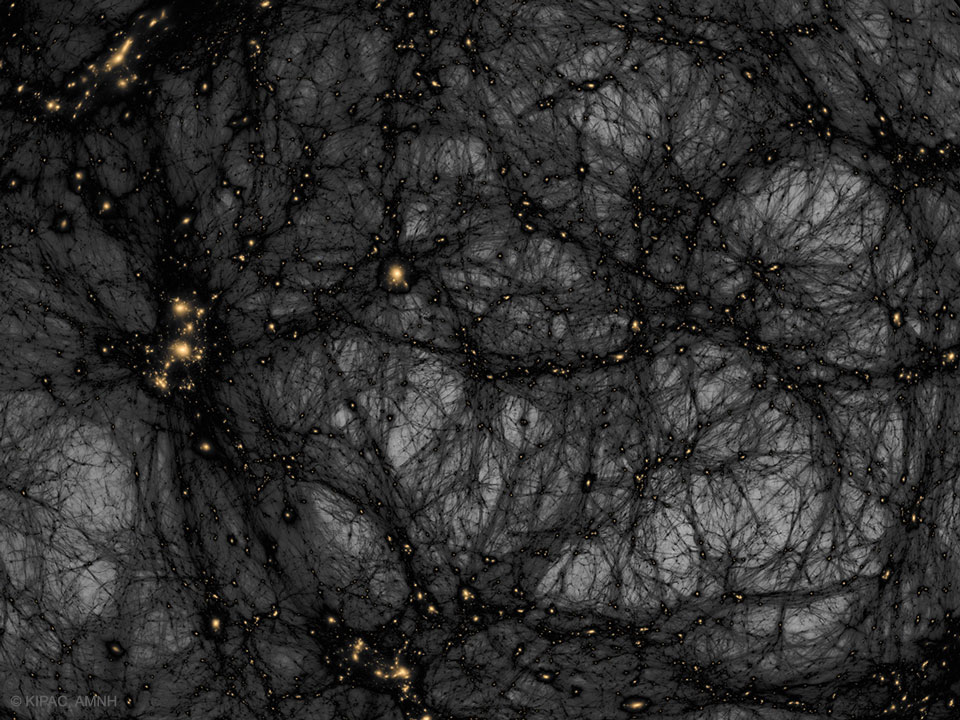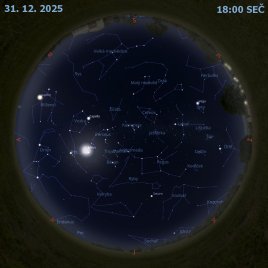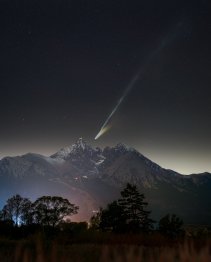Temná hmota v simulovaném vesmíru

Uznání a copyright ilustrace: Tom Abel & Ralf Kaehler (KIPAC, SLAC), AMNH
Strašilo v našem vesmíru? Podle této mapy temné hmoty to tak může vypadat. Gravitace neviditelné temné hmoty je hlavním vysvětlením toho, proč galaxie rotují tak rychle, proč galaxie obíhají kolem kup tak rychle, proč gravitační čočky tak silně vychylují světlo, a proč je viditelná hmota rozložena tak, jak je v lokálním vesmíru i v kosmickém záření mikrovlného pozadí. Obraz zobrazující temný vesmír z Haydenova planetária Amerického muzea přírodní historie ukazuje jeden příklad, jak všudypřítomná temná hmota může strašit v našem vesmíru. Obraz pochází z podrobné počítačové simulace a po celém vesmíru jsou složitá vlákna temné hmoty, zde zobrazená černou barvou, roztažená jako pavoučí sítě, zatímco poměrně vzácné shluky známé baryonové hmoty mají oranžové zbarvení. Tyto simulace se dobře statisticky shodují s astronomickými pozorováními. Co se možná ukazuje ještě děsivějším, je, že tmavá hmota, ačkoli i tak dosti podivná a v neznámé podobě, se již nepovažuje za nejpodivnější zdroj gravitace ve vesmíru. Tato čest nyní připadá temné energii, jednotnějšímu zdroji odpudivé gravitace, který nyní zřejmě dominuje rozpínání celého vesmíru.
Seznam odkazů v popisu
- NASA: What Is Dark Matter?
- Harvard.edu: Chandra: Dark Matter
- Arizona.edu: Dark Matter: another basic part of galaxies!!
- Medium.com: Galaxy clusters prove dark matter’s existence
- LSST.org: Gravitational lensing
- APOD: 2014-05-12 Simulace Vesmíru od Illustrisu
- Berkeley.edu: MODELS OF STRUCTURE FORMATION
- Uchicago.edu: Dark Matter Density
- APOD: 2013-03-25 Planck zmapoval mikrovlnné pozadí
- AMNH.org: Hayden planetarium
- AMNH.org: American Museum of Natural History
- YouTube.com: Dark Matter
- APOD: 2011-10-03 Video temné hmoty ze simulace Bolshoi
- BadSpiderBites.com: Giant Spider Webs
- Wikipedia: Baryon
- Stanford.edu: RALF KÄHLER - VISUALIZATIONS: DARK MATTER & LARGE SCALE STRUCTURES
- Wikipedia: Dark_matter
- Home.cern: Dark matter
- Harvard.edu: Adventures in Friedmann cosmology: A detailed expansion of the cosmological Friedmann equations
- NASA: Dark Matter & Dark Energy
- PreposterousUniverse.com: Why Does Dark Energy Make the Universe Accelerate?
NASA Official: Phillip Newman Specific rights apply. NASA Web Privacy Policy and Important Notices
A service of: ASD at NASA / GSFC & Michigan Tech. U.
Odkaz na originální APOD


